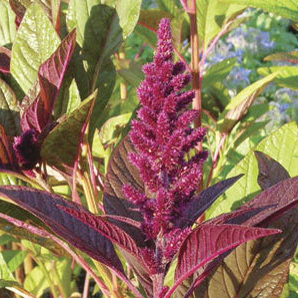Amaranth: A Grain for All Ages
By Suzanne Nelson
Special thanks to Native Seed Search for permission to reprint this article. View the original (plus recipes) here.
 An ancient crop domesticated in the Americas, amaranth has known both grandeur and obscurity. Considered a food of the Gods by the Aztecs, amaranth was a king among grains prior to the arrival of the Spanish in the New World. Important as both a ritual and cash crop, amaranth was used as tribute payment to the Aztec Empire from surrounding provinces, with nearly as much amaranth offered annually as corn and beans. The leaves, known as “huautli,” were used as a vegetable and cooked liked spinach. Today, amaranth greens are commonly known as “quelite” or “bledo.” Though a staple food for the Aztecs, amaranth was also considered sacred and was used in numerous ceremonies and religious rituals. The leaves were ground and used in tamales offered to Xiuhtecuhtli, the fire god. Ground amaranth seed was mixed with honey, sap from the maguey (agave) or blood and formed into shapes of various idols. These sacred figurines were then eaten ceremonially, a practice abhorred by the conquering Spanish as too closely approximating their own ritual observance of communion. Thus, all production and use of amaranth was banned by the Spanish. Amaranth was nearly forgotten as a crop. Luckily, its cultivation persisted in isolated pockets throughout Mesoamerica. Amaranth was also used and revered by the Incas in South America, where remoteness of the Andes provided safe haven for isolated pockets of amaranth cultivation, also helping it to persist despite the Americas-wide ban.
An ancient crop domesticated in the Americas, amaranth has known both grandeur and obscurity. Considered a food of the Gods by the Aztecs, amaranth was a king among grains prior to the arrival of the Spanish in the New World. Important as both a ritual and cash crop, amaranth was used as tribute payment to the Aztec Empire from surrounding provinces, with nearly as much amaranth offered annually as corn and beans. The leaves, known as “huautli,” were used as a vegetable and cooked liked spinach. Today, amaranth greens are commonly known as “quelite” or “bledo.” Though a staple food for the Aztecs, amaranth was also considered sacred and was used in numerous ceremonies and religious rituals. The leaves were ground and used in tamales offered to Xiuhtecuhtli, the fire god. Ground amaranth seed was mixed with honey, sap from the maguey (agave) or blood and formed into shapes of various idols. These sacred figurines were then eaten ceremonially, a practice abhorred by the conquering Spanish as too closely approximating their own ritual observance of communion. Thus, all production and use of amaranth was banned by the Spanish. Amaranth was nearly forgotten as a crop. Luckily, its cultivation persisted in isolated pockets throughout Mesoamerica. Amaranth was also used and revered by the Incas in South America, where remoteness of the Andes provided safe haven for isolated pockets of amaranth cultivation, also helping it to persist despite the Americas-wide ban.
Commonly referred to as “pigweed;’ amaranth (Amaranthus spp.) is closely related to lamb’s quarters (Chenopodium spp.), as well as cockscomb (Celosia spp.). Amaranth is widely distributed around the world with approximately 60 known species. It is an annual plant separately domesticated in the Andes and in central Mexico (along with corn, beans and gourds) nearly 7000 years ago (5000 BC). While most Amaranthus spp. are considered wild or weedy, a few are cultivated, including both grain and vegetable types used primarily for their seeds or young leaves, respectively. There is no strict taxonomic difference between grain and vegetable amaranths, as the leaves of young grain types are also eaten as greens. However, A. hypochondriacus, A. caudatus, and A. cruentus are considered the principal grain amaranths while A. tricolor is grown for its tender leaves (along with A. cruentus). Several wild species, A. palmeri and A. hybridus, were utilized by Native Americans in the southwestern US. The diminutive Seabeach amaranth (A. pumilus) grows on Atlantic Ocean beach dunes and is considered threatened under the Endangered Species Act. Yet other species of amaranth are considered among the world’s worst weeds!
Cultivated amaranths are bushy and typically grow 5-7 ft tall. The leaves are broad with the flowering head appearing somewhat like a feathery plume. Amaranth plants and flowers vary in color, from plants with green leaves and flowers to plants with red-tinged green leaves to plants with red leaves and flowers. The seeds of amaranth are very small and can range from blond to deep red. Amaranth is predominantly a self-pollinating crop, though varying degrees of out-crossing have been noted. Thus, when growing more than one variety of amaranth, care must be taken to isolate each variety by sufficient distance to prevent cross pollination. With 36 distinct collections of amaranth in the Native Seed Search Seed Bank, this would require a lot of land (the recommended distance is up to 1 mile between varieties!). Instead, we utilize “bags” constructed of finely woven fibers that fit over the flowering structure and tie around the stalk. In this manner, we were able to grow 12 different amaranths during the summer of 2005.
In Mexico, amaranth is typically popped and mixed with sugar or honey to make a candy referred to as “alegria’: Ground roasted amaranth seed is also used to make “atole”, a traditional and highly nutritious drink. Tender young leaves are harvested and eaten much like spinach. In Peru, amaranth seed is fermented to make a beer locally known as “chichi”. Flowers are used to treat toothache and fevers, as well as for coloring maize and quinoa.
Though grown on a large scale by the Aztecs and utilized around the globe, such as in China, India, Africa, Nepal, south Pacific Islands, Caribbean, Greece, Italy and Russia, amaranth is considered a “new crop”. It has undergone somewhat of a “resurgence” as interest in its nutritional properties become more well-documented. Amaranth is considered a nearly “perfect” food considering its high quality protein content, digestibility, and essential amino acid make-up. Grain amaranth contains 12-18% protein, higher than many other grains and has significantly higher lysine levels. Combining amaranth with other grains greatly enhances the nutritional value of processed foods. Amaranth seed is high in fiber and contains calcium, iron, potassium, phosphorus and vitamins A and C. Oil from the seeds contains tocotrienols (a form of vitamin E) which are thought to help lower cholesterol levels. Leaves of amaranth are also highly nutritious and have higher levels of calcium, iron and phosphorous than spinach.
Amaranth is still produced in large quantities in the states of Morelos, Mexico, Puebla, Tlaxcala and to a lesser degree in Oaxaca. It remains an important ingredient in many regional dishes such as moles, pipians, soups, and desserts. In the US, interest in amaranth was stimulated during the 1970s as a result of efforts by the Rodale Research Institute. Today, amaranth is produced primarily in Minnesota, Nebraska, Montana and Wisconsin, with the amount of acreage being planted each year slowly on the increase. It is fast-growing (thanks in large part to its C4 metabolism – a more efficient strategy for utilizing CO2 during photosynthesis), drought tolerant and grows most anywhere, particularly in areas of high sunlight and warm temperatures. The ease of growing and harvesting amaranth, its ability to grow in marginal soils with no irrigation, and its high nutritive value, have made amaranth a potentially important crop for poor farmers in the developing world.
”Amaranthus” comes from the Greek word “amarantos” meaning “never fading” and represented immortality. Amaranths are named after the Greek goddess Artemis, twin sister to Apollo, who was also known as Amarynthia (as well as Cynthia). Artemis was considered the goddess of hunting and would become known as Diana after a name change by the Romans.






